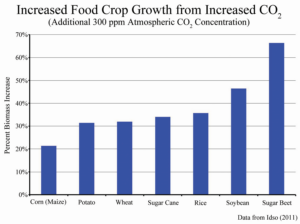Political and business leaders, educators, and the news media endlessly talk about “carbon.” Newscasters repeatedly warn about “carbon emissions” and “carbon pollution.” States and provinces announce “zero carbon” goals. The United Nations and environmental groups push for a “low-carbon” and a “carbon-neutral” society. But instead, they should all be talking about “carbon dioxide,” not carbon.
Labeling carbon dioxide “carbon” is as foolish as calling salt “chlorine.” Carbon and carbon dioxide (CO2) are completely different substances. The term “carbon” conveys an image of black pencil lead or soot, but CO2 is an invisible gas. It appears that CO2 is deliberately being misnamed to convey a negative image.
Emissions of carbon dioxide by industry are blamed for enhancing Earth’s greenhouse effect and causing dangerous global warming. As a result, leaders across the world talk about “carbon pollution.” Former EPA Administrator Gina McCarthy said,
“I view climate as a pollution problem. It is, in my words, carbon pollution. It’s just like every other pollutant.”
Ms. McCarthy and others should be using the term “carbon dioxide.” But in addition, the idea that carbon dioxide is pollution is one of the greatest misconceptions of our time.
Carbon dioxide is not a pollutant. It’s an odorless, harmless, invisible gas. It doesn’t cause smoke or smog. The white cloud rising from the cooling tower of a power plant isn’t carbon dioxide; it’s condensing water vapor. You can’t see carbon dioxide. We inhale only a trace of CO2, but as we burn sugars in our bodies, we continuously produce carbon dioxide. Every time each one of us exhales, we exhaust air with 100 times the carbon dioxide concentration that is in the atmosphere. The average person exhales about two pounds (0.9 kilograms) of CO2 per day.
Climate scientists agree that Earth’s dominant greenhouse gas is not carbon dioxide or methane, but water vapor. Water vapor and clouds are responsible for between 70 and 90 percent of Earth’s greenhouse effect.
High school chemistry teaches that the equation for combustion is:
Fuel + O2 + Heat → CO2 + H2O
For example, when natural gas is burned, two water vapor molecules are exhausted for each molecule of carbon dioxide produced. Suppose we label carbon dioxide a pollutant because it is emitted by industry and enhances Earth’s greenhouse effect. In that case, sensible logic requires us also to call water a pollutant, a bizarre result.
As a matter of fact, CO2 is green! Carbon dioxide is plant food. Hundreds of peer-reviewed studies show that CO2 makes plants grow bigger and faster. Plants grow larger fruits, larger vegetables, thicker stems, and bigger root systems, and they are more resistant to drought with higher levels of atmospheric carbon dioxide. Studies show that all 45 crops that provide 95 percent of the world’s total food production grow significantly larger with increased levels of CO2. Carbon dioxide joins water and oxygen as one of the three essential substances for life on Earth. Yet many companies and most universities now foolishly measure their “carbon footprint” and strive to reduce CO2 emissions.
The term “carbon footprint” is meant to describe the amount of carbon dioxide emitted by persons or groups due to the combustion of hydrocarbon fuels. But everything we do in modern society emits carbon dioxide. The manufacture, transportation, and construction of wind turbines, solar cells, heat pumps, and electric vehicles all produce CO2 emissions, just like most other activities in modern society.
Carbon capture and storage (CCS) is another mislabeled remedy proposed to halt global warming. But no carbon is captured, only carbon dioxide gas. In addition, 72 percent of the gas captured is oxygen by molecular weight. It would be more accurate to call CCS “oxygen capture and storage.”
Suppose we start calling “carbon” CO2 or “carbon dioxide” and quit referring to it as a pollutant?
This article originally appeared at Master Resource

